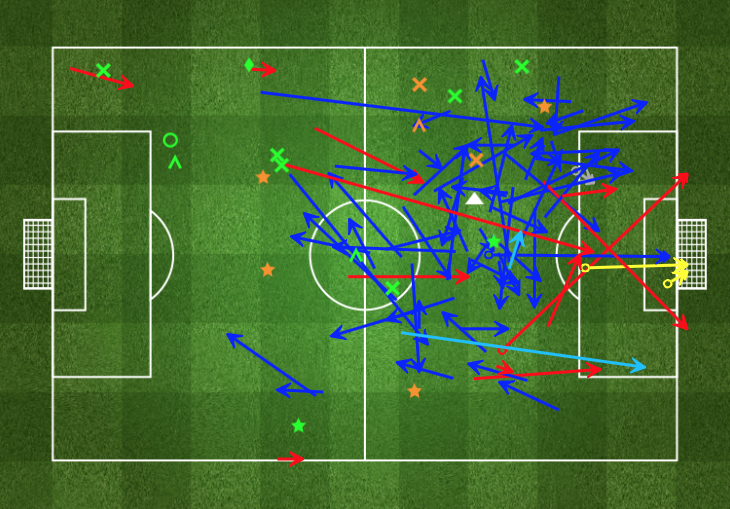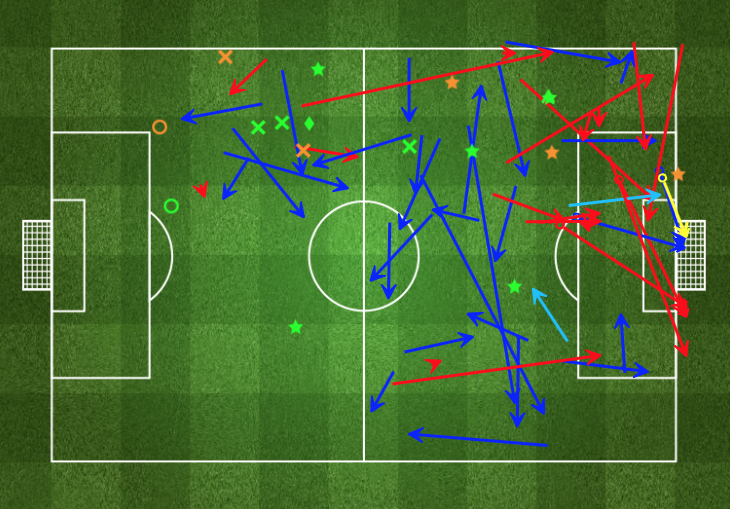Recently Sky Sports News displayed an infographic showcasing the decline of Alexis Sanchez since Mesut Özil has returned from injury. From goals at better than every second game in the first half of the season, to none in seven since his return. Many Arsenal fans, used to the German receiving a lot of criticism in the English press, felt this was a ridiculous new method of attack at the player when he was performing exceptionally. However, it is a true point that so far this season Arsenal’s two most expensive ever signings have failed to coincide their best performances together. And this is an issue which goes beyond simply those two. The reality is that as good as the Chilean has been this season, his best performances haven’t necessarily seen a strong performance from the team overall.
Alexis’ best form this season arguably came in the Autumn and early winter, where he battered the likes of Hull (x2), Sunderland, Burnley, Anderlecht, QPR, and Stoke. In those seven fixtures he scored ten and assisted another four. He spent much of this time as the number 10 in a 4-2-3-1 or as a second striker in a 4-4-2. The team was built around him to be the main attacking weapon, and this was seen by him dominating with the number of touches in most games. But this was at a time when Arsenal often struggled. They were outside the top four, and there were disappointing defeats to Swansea, Manchester United, Stoke, Southampton and draws against lowly Hull and Leicester. At the same time you started to see stats about where Arsenal would be without Alexis’ goals and assists, often as far down as the relegation zone and the ridiculous “Alexis FC” comments that followed. Arsenal obviously wouldn’t have been down there without Alexis this season, which begs the question, why weren’t others performing to the extent they could have while Alexis was dominating?
Have a think about some of the goals Alexis has scored this season. Now think about how many have come at the end of wonderful, intricate passing, team moves. There haven’t been many. There were the spectacular strikes against City, Anderlecht and Dortmund. There was the brace at Sunderland where both came from frenetic individual pressing to win the ball. And then there are countless examples of goals which came at the end of a dribble or piece of individual skill. One goal even came from a Per Mertesacker assist, such was the individuality about his run from deep and wide and his finish from a tight angle. Probably only goals against Burnley and Swansea stand out for being great team goals.
Playing as the main weapon in Arsenal’s attack, Alexis obviously had the best possibility to showcase his strongest attributes. The explosive power, dribbling, pace, shooting and creative side. He theoretically had it all and was prolific as a result. But having a player of his ilk as the centre of the attack, and the person on the ball the most, hurts the team in other ways. Alexis is dispossessed considerably more than anyone else in the squad, and combined with his passing accuracy of 76.5%, meant Arsenal weren’t able to sustain attacks regularly. Additionally he’s much less of a give and go player. He often dwells on the ball and this reduced the fluidity of Arsenal’s attacks. As a result of this Arsenal’s team play got worse and they become a side much more reliant on a piece of individual brilliance to get them goals, which Sanchez was best placed to provide. Hence you get “Arsenal would be 18th without Alexis!”. Here for example, is his player dashboard against Sunderland this season.
More recently, with the return of Mesut Özil and the dominance of Santi Cazorla centrally since December, Arsenal as a team have improved. Both Özil and Cazorla get dispossessed at half the rate Alexis does and both complete greater than 10% more of their passes. Neither of these two are as direct and explosive as Alexis, so they might not individually register as many goals and assists. However, they are better at controlling a game and building play. As a result it’s more preferable to have those two on the ball the majority of the time and Arsenal’s form and performances have got much better since.
With those two pulling the strings as the heart of the midfield and attack Alexis has to act as more of an outlet. Almost like an upgraded Theo Walcott. Less time on the ball as a creative force but someone who is lethal in front of goal, makes good off the ball runs, and offers great dribbling and the potential for something different if attacks are becoming stale. This is something he did more prominently at Barcelona. With Messi, Iniesta and Xavi hogging the ball Alexis didn’t pass as much, made fewer dribbles and generally got less involved than he has at Arsenal, but he did manage to score at a better rate in his final season. Here’s his hat-trick against Elche from January 2014. Compare it to the game against Sunderland this October.
While it’s perhaps slightly concerning some of Arsenal’s best offensive players haven’t quite shown brilliant chemistry yet, it’s also encouraging. Arsenal are 3rd, have scored 53 league goals and are averaging 15.6 shots a game. This despite injuries and all their attacking armoury failing to really fire at the same time. Just imagine what they could do if they found the magic formula.
Even if Alexis fails to rediscover that October to early January magic where he seemingly destroyed teams on his own, it’s not necessarily a bad thing or something to slate him for either. For Arsenal it’s about getting the best out of all the players in the team and if Alexis dominating a little bit less sees an improvement in everyone else, and in results, I’m sure few will mind.
Oscar Wood
Latest posts by Oscar Wood (see all)
- So this is what Arsenal getting the best out of Aaron Ramsey looks like - December 9, 2017
- Why Arsenal Should Attempt to Break the Bank on Mateo Kovacic - July 28, 2017
- Why Arsenal must give Xhaka and Ramsey a run of games in the midfield - November 25, 2016



